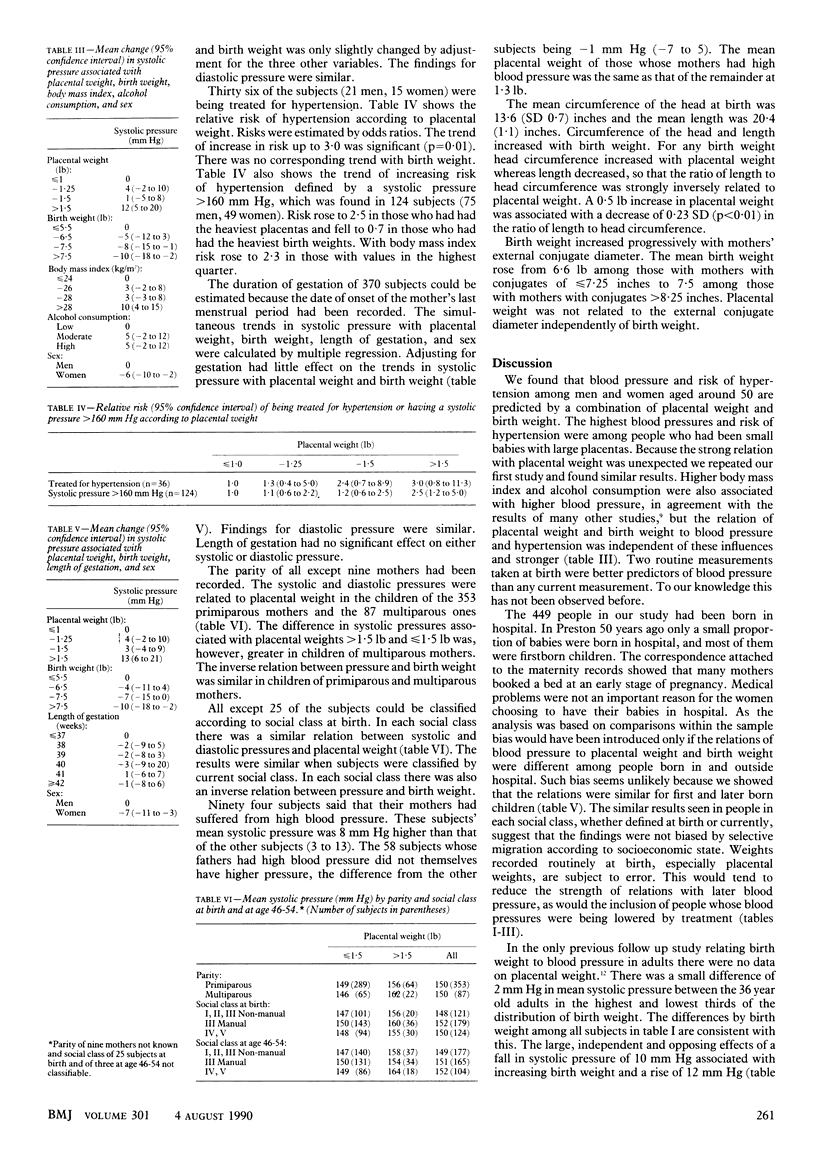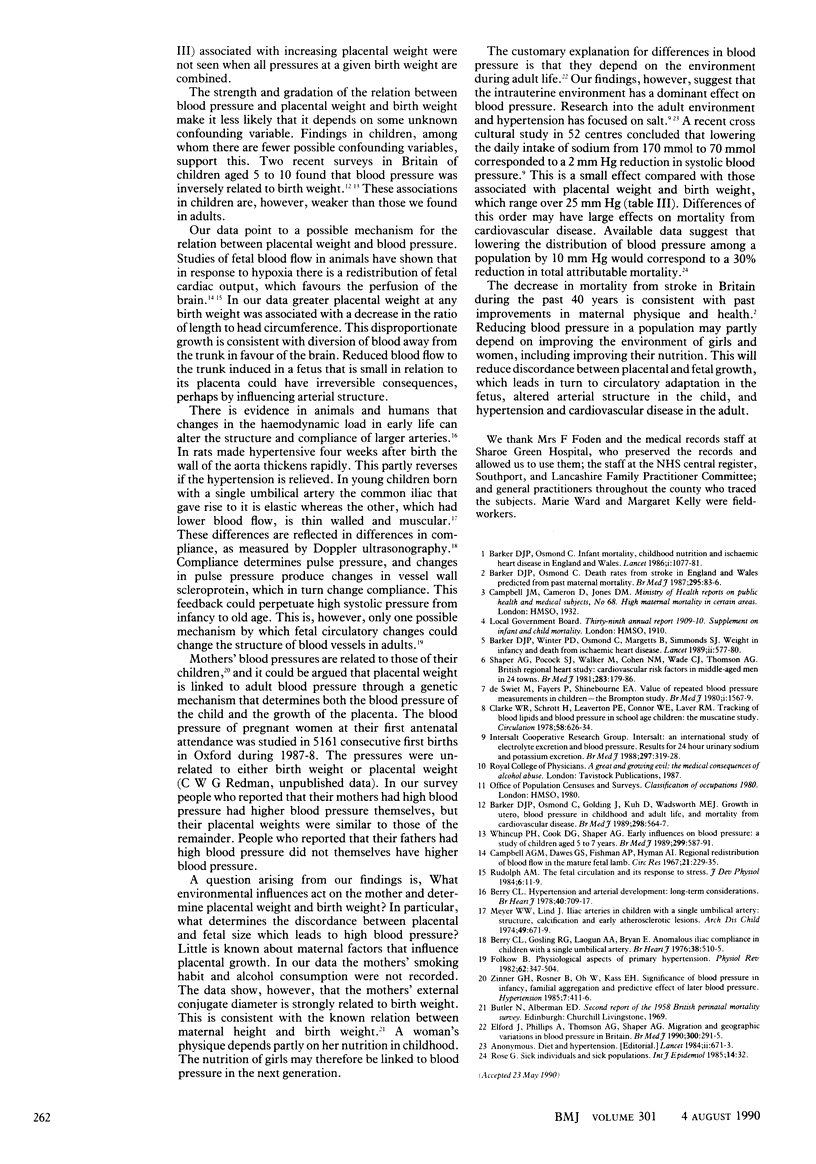Abstract
OBJECTIVE--To study the effect of intrauterine growth and maternal physique on blood pressure in adult life. DESIGN--A follow up study of infants born 50 years previously whose measurements at birth were recorded in detail. SETTING--Preston, Lancashire. SUBJECTS--449 Men and women born in hospital in Preston during 1935-43 and still living in Lancashire. MAIN OUTCOME MEASURES--Placental weight, birth weight, and blood pressure at age 46 to 54 years. RESULTS--In both sexes systolic and diastolic pressures were strongly related to placental weight and birth weight. Mean systolic pressure rose by 15 mm Hg as placental weight increased from less than or equal to 1 lb (0.45 kg) to greater than 1.5 lb and fell by 11 mm Hg as birth weight increased from less than or equal to 5.5 lb to greater than 7.5 lb. These relations were independent so that the highest blood pressures occurred in people who had been small babies with large placentas. Higher body mass index and alcohol consumption were also associated with higher blood pressure, but the relations of placental weight and birth weight to blood pressure and hypertension were independent of these influences. CONCLUSIONS--These findings show for the first time that the intrauterine environment has an important effect on blood pressure and hypertension in adults. The highest blood pressures occurred in men and women who had been small babies with large placentas. Such discordance between placental and fetal size may lead to circulatory adaptation in the fetus, altered arterial structure in the child, and hypertension in the adult. Prevention of hypertension may depend on improving the nutrition and health of mothers.
Full text
PDF



Selected References
These references are in PubMed. This may not be the complete list of references from this article.
- Barker D. J., Osmond C. Death rates from stroke in England and Wales predicted from past maternal mortality. Br Med J (Clin Res Ed) 1987 Jul 11;295(6590):83–86. doi: 10.1136/bmj.295.6590.83. [DOI] [PMC free article] [PubMed] [Google Scholar]
- Barker D. J., Osmond C., Golding J., Kuh D., Wadsworth M. E. Growth in utero, blood pressure in childhood and adult life, and mortality from cardiovascular disease. BMJ. 1989 Mar 4;298(6673):564–567. doi: 10.1136/bmj.298.6673.564. [DOI] [PMC free article] [PubMed] [Google Scholar]
- Barker D. J., Osmond C. Infant mortality, childhood nutrition, and ischaemic heart disease in England and Wales. Lancet. 1986 May 10;1(8489):1077–1081. doi: 10.1016/s0140-6736(86)91340-1. [DOI] [PubMed] [Google Scholar]
- Barker D. J., Winter P. D., Osmond C., Margetts B., Simmonds S. J. Weight in infancy and death from ischaemic heart disease. Lancet. 1989 Sep 9;2(8663):577–580. doi: 10.1016/s0140-6736(89)90710-1. [DOI] [PubMed] [Google Scholar]
- Berry C. L., Gosling R. G., Laogun A. A., Bryan E. Anomalous iliac compliance in children with a single umbilical artery. Br Heart J. 1976 May;38(5):510–515. doi: 10.1136/hrt.38.5.510. [DOI] [PMC free article] [PubMed] [Google Scholar]
- Berry C. L. Hypertension and arterial development. Long-term considerations. Br Heart J. 1978 Jul;40(7):709–717. doi: 10.1136/hrt.40.7.709. [DOI] [PMC free article] [PubMed] [Google Scholar]
- Campbell A. G., Dawes G. S., Fishman A. P., Hyman A. I. Regional redistribution of blood flow in the mature fetal lamb. Circ Res. 1967 Aug;21(2):229–235. doi: 10.1161/01.res.21.2.229. [DOI] [PubMed] [Google Scholar]
- Clarke W. R., Schrott H. G., Leaverton P. E., Connor W. E., Lauer R. M. Tracking of blood lipids and blood pressures in school age children: the Muscatine study. Circulation. 1978 Oct;58(4):626–634. doi: 10.1161/01.cir.58.4.626. [DOI] [PubMed] [Google Scholar]
- Elford J., Phillips A., Thomson A. G., Shaper A. G. Migration and geographic variations in blood pressure in Britain. BMJ. 1990 Feb 3;300(6720):291–295. doi: 10.1136/bmj.300.6720.291. [DOI] [PMC free article] [PubMed] [Google Scholar]
- Folkow B. Physiological aspects of primary hypertension. Physiol Rev. 1982 Apr;62(2):347–504. doi: 10.1152/physrev.1982.62.2.347. [DOI] [PubMed] [Google Scholar]
- Rudolph A. M. The fetal circulation and its response to stress. J Dev Physiol. 1984 Feb;6(1):11–19. [PubMed] [Google Scholar]
- Shaper A. G., Pocock S. J., Walker M., Cohen N. M., Wale C. J., Thomson A. G. British Regional Heart Study: cardiovascular risk factors in middle-aged men in 24 towns. Br Med J (Clin Res Ed) 1981 Jul 18;283(6285):179–186. doi: 10.1136/bmj.283.6285.179. [DOI] [PMC free article] [PubMed] [Google Scholar]
- Whincup P. H., Cook D. G., Shaper A. G. Early influences on blood pressure: a study of children aged 5-7 years. BMJ. 1989 Sep 2;299(6699):587–591. doi: 10.1136/bmj.299.6699.587. [DOI] [PMC free article] [PubMed] [Google Scholar]
- de Swiet M., Fayers P., Shinebourne E. A. Value of repeated blood pressure measurements in children--the Brompton study. Br Med J. 1980 Jun 28;280(6231):1567–1569. doi: 10.1136/bmj.280.6231.1567. [DOI] [PMC free article] [PubMed] [Google Scholar]


